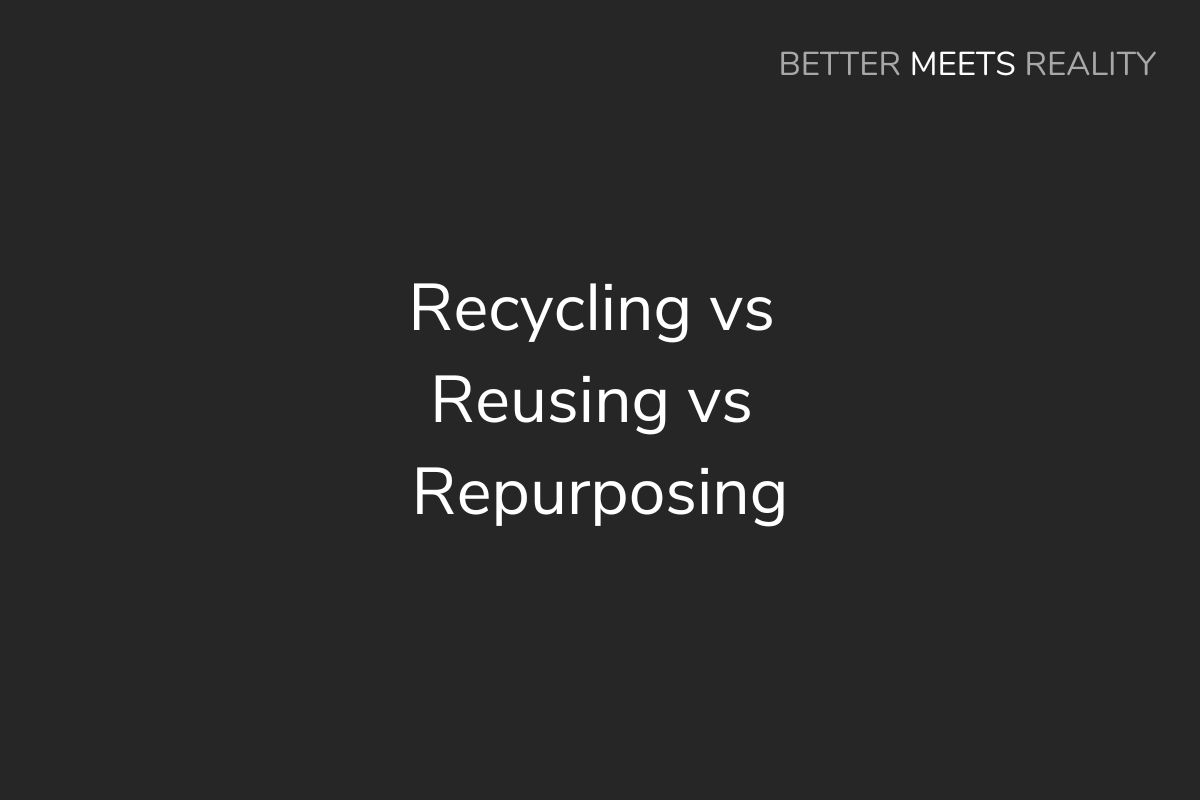In the guide below, we compare recycling vs reusing vs repurposing.
We outline what each one is, the differences between them, and which might be better for different types of waste and applications.
Recycling vs Reusing vs Repurposing: Differences
The main differences between these three are:
– Recycling
Involves collecting and processing waste and materials into recycled material (there’s various recycling methods to break down and process waste & materials), that can then be used in new materials and new products
Some common forms of recycling process waste into recycled material that has the same or similar quality or value as the original material
Having said that, several reports, such as the listed wikipedia.org guide, note that recycling can sometimes become a form of downcycling, as some materials degrade in quality the more they are recycled (some plastics are an example of this, whereby polymer bonds weaken in the plastic)
– Reusing
Unlike recycling, reusing does not involve the collection and processing (or breaking down) of waste and materials
Reusing is generally the re-using of a product, item, material, or type of waste, for a similar or different use compared to the original use, without breaking them down in an energy intensive or more complex way
Reusing doesn’t have to involve just reusing waste – it can involve reusing existing products in some way before they become waste
Therefore, a key feature of re-using might be extending a product’s life or longevity before it becomes waste
Reusing can take many forms, such as servicing, repairing, restoring or refurbishing, selling pre-used (re-sale), donating, swapping, renting and leasing, and more
Read more about some potential examples of reuse in this guide
– Repurposing
Repurposing can include reuse, and some reports even classify both as the same thing
However, repurposing might be a form of reusing, and therefore have a slightly different definition than reuse
Repurposing generally involves reusing an item, material, or type of waste, solely for a different or alternative use than the original use
Repurposing can involve using the item or material by itself in it’s original form, modifying it, or it might even involve incorporation with other items or materials for a new application
Repurposing might generally be done with something that would have been thrown out otherwise, or with something that is already considered waste or junk
Read more about some potential examples of repurposing in this guide
*The Involvement Of Upcycling & Downcycling
Reuse and repurposing can involve both the upcycling and downcycling of materials in different ways
Recycling generally does not, although, the continued recycling of some materials can result in downcycling those materials as they become lower quality or more inferior in durability or a number of other traits
Recycling vs Reusing vs Repurposing: Which Is Better?
The method of waste management that is best depends on a few key factors such as:
– The item/product in question, or the waste or material being managed
– What the end use for the item or waste material will be
Some of the considerations that might be taken into account might include:
– Some waste materials aren’t suitable for recycling, reuse, or repurposing
Whether it’s because of the physical traits of the item or material, or another reason such as it not being profitable to recycle, reuse, or repurpose the item or material
– Recycling might be best for …
Recyclable waste and materials that should be broken down and processed, and converted into recycled material
It might also be best for waste and materials that can be used for a similar end use to the original use of the material
One good example of this might be PET plastic bottles that are recycled back into PET plastic bottles
– Reuse might be best for …
Both new products and waste material that can be reused again without having to be sent to a recycling facility to be processed and converted into recycled material.
For example, there’s a range of re-usable products on the market such as reusable drink bottles, reusable bags, reusable cutlery, reusable containers, and more.
Existing products can also be repaired and re-used instead of being discarded when they experience a problem that leads to them temporarily discontinuing to function, such as laptops and smartphones.
Instead of being thrown out, clothing can also be gifted, or sold pre-worn, and used again by a new owner.
– Repurposing might be suitable where …
A product or material is going to be thrown out, or has reached the end of it’s lifespan for it’s original use, and it can still be used for an alternative use.
An example of repurposing might be a shopping bag that isn’t suitable to carry shopping items anymore, but can be used to store other items at home, or, can be repurposed for another use such being a bin liner.
Other Guides On Recycling, Reusing & Repurposing
Potential Pros & Cons Of Recycling
Potential Pros & Cons Of Reuse & Repurposing
Sources
1. Various ‘Better Meets Reality’ guides
2. https://en.wikipedia.org/wiki/Downcycling
3. https://en.wikipedia.org/wiki/Repurposing
','' ); } ?>